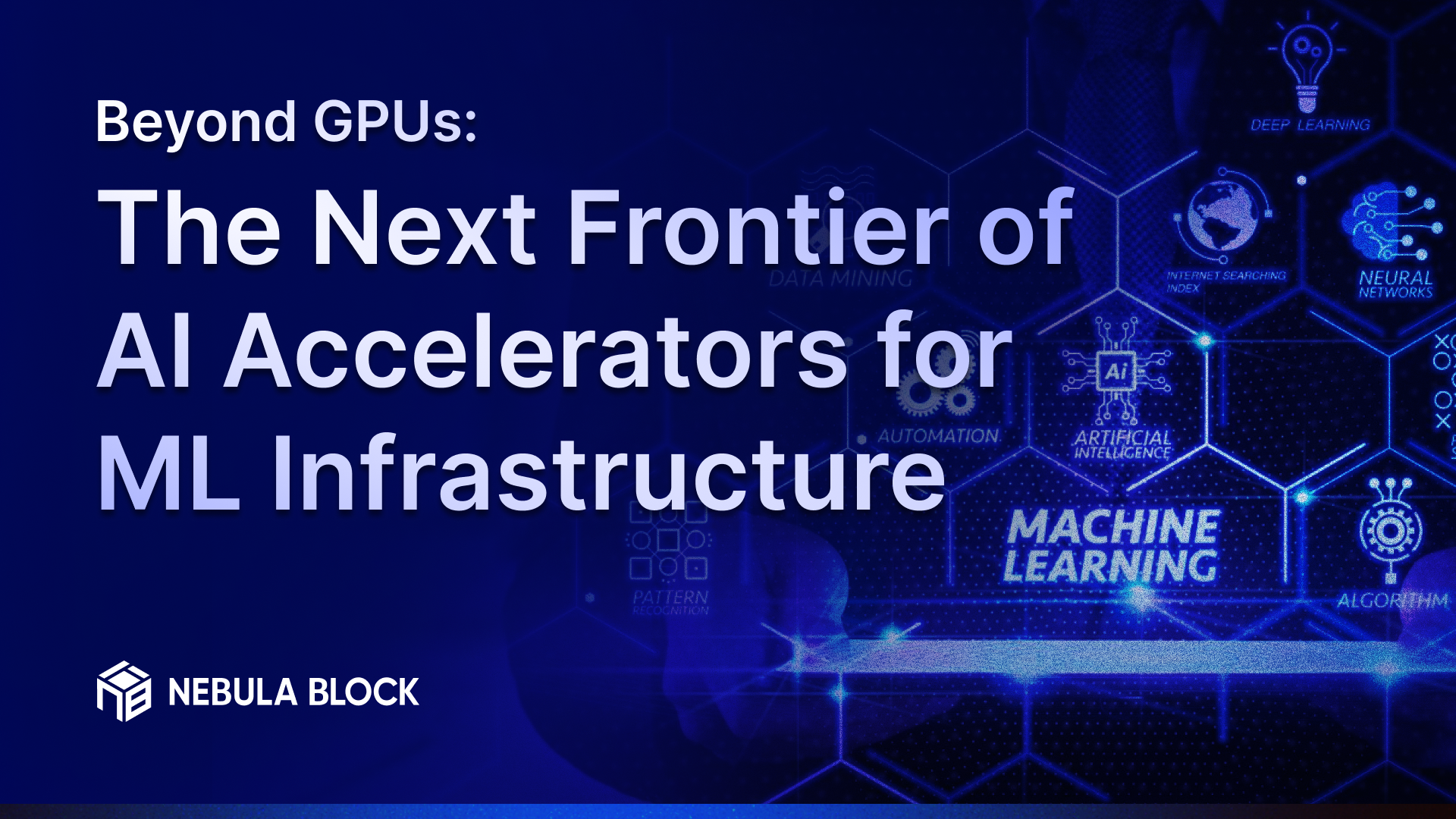Beyond GPUs: The Next Frontier of AI Accelerators for ML Infrastructure

Introduction
As machine learning (ML) workloads scale, GPUs like NVIDIA’s H100 have set the standard for training and inference. However, emerging AI accelerators—ASICs, FPGAs, photonic, and neuromorphic chips—are reshaping ML infrastructure with specialized performance and efficiency. Nebula Block’s serverless platform, powered by H100/H200 GPUs, offers a robust benchmark to explore these innovations. This blog examines their impact on ML infrastructure and the future of cost-efficient AI.
The Current Landscape: Evolving Compute Demands
GPUs excel in parallel processing, with Nebula Block’s H100 instances delivering 10,000+ samples/second for LLM training at $3.22/hour (18% less than $3.933 elsewhere). However, GPUs’ high power use (1,700W per H100) and general-purpose design limit efficiency for edge inference or sparse networks. Emerging accelerators address these gaps with low-latency, energy-efficient solutions.
Emerging AI Accelerators
- ASICs: Custom chips optimize matrix operations for specific ML tasks, offering 2x energy efficiency over GPUs for inference. Drawback: high design costs limit flexibility.
- FPGAs: Reconfigurable for tasks like real-time computer vision, FPGAs reduce latency (e.g., 20μs for autonomous navigation) but require complex programming.
- Photonic Accelerators: Optical chips like ADEPT perform matrix multiplications at 0.1 aJ/MAC, slashing energy use for large-scale training. Challenges include integration complexity.
- Neuromorphic Chips: Mimicking brain-like processing, chips like SiMa.ai’s MLSoC (50 TOPS at 10W) excel in sparse, low-power edge tasks but lack maturity for general ML.
These accelerators enable low-latency edge computing, energy-efficient training, and specialized inference, addressing GPU limitations for IoT, robotics, and generative AI.
Nebula Block at the Forefront of Cost-Effective Innovation
Nebula Block’s platform, with H100/H200 GPUs across 100+ data centers, supports hybrid ML infrastructure. Developers can deploy serverless endpoints with vLLM for optimized LLM inference:
import requests
import os
url = "https://inference.nebulablock.com/v1/chat/completions"
headers = {
"Content-Type": "application/json",
"Authorization": f"Bearer {os.environ.get('NEBULA_API_KEY')}"
}
data = {
"messages":[
{"role":"user","content":"Is Montreal a thriving hub for the AI industry?"}
],
"model":"gemini/gemini-2.5-pro-preview-05-06",
"max_tokens":None,
"temperature":1,
"top_p":0.9,
"stream":False
}
response = requests.post(url, headers=headers, json=data)
print(response.json())Conclusion: What’s Next for ML Infrastructure?
By 2030, global Cloud AI market may hit $463.2B, driven by accelerators enabling edge AI, quantum-enhanced ML, and sustainable computing. The future of AI compute is not solely in more powerful GPUs, but in a blend of specialized accelerators that together create a flexible, efficient, and cost-effective infrastructure. As the industry moves beyond traditional GPU paradigms, platforms like Nebula Block are ideally positioned to lead this transition.
Next Steps
Sign up, explore the tech and stay ahead in the AI revolution! Test serverless LLM inference or schedule a demo to integrate emerging accelerators.
🔍 Learn more: Visit our blog and documents for more insights or schedule a demo to optimize your search solutions.
📬 Get in touch: Join our Discord community for help or Contact Us.
Stay Connected
💻 Website: nebulablock.com
📖 Docs: docs.nebulablock.com
🐦 Twitter: @nebulablockdata
🐙 GitHub: Nebula-Block-Data
🎮 Discord: Join our Discord
✍️ Blog: Read our Blog
📚 Medium: Follow on Medium
🔗 LinkedIn: Connect on LinkedIn
▶️ YouTube: Subscribe on YouTube